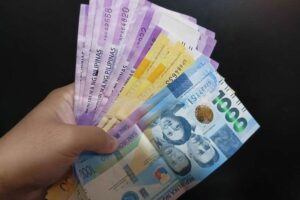




Policy Rate Updates: Double cut finale
 DOWNLOAD
DOWNLOAD

Monthly Economic Update: One for the road
 DOWNLOAD
DOWNLOAD

Inflation Update: Still low, still slow
 DOWNLOAD
DOWNLOAD


Peso may move sideways vs dollar as market awaits PCE price index data

The peso could trade sideways against the dollar this week as the market awaits the release of the August US personal consumption expenditure (PCE) price index data for hints on the Federal Reserve’s next policy move.
The local unit closed at PHP 55.69 per dollar on Friday, weakening by eight centavos from its PHP 55.61 finish on Thursday, Bankers Association of the Philippines data showed.
Still, week on week, the peso surged by 30.5 centavos from its PHP 55.995 finish on Sept. 13.
The peso weakened against the dollar on Friday after the Bangko Sentral ng Pilipinas (BSP) announced a surprise cut in banks’ reverse requirement ratios (RRR), Rizal Commercial Banking Corp. Chief Economist Michael L. Ricafort said in a Viber message.
The BSP on Friday said it will reduce the RRR for universal and commercial banks and nonbank financial institutions with quasi-banking functions by 250 basis points (bps) to 7% effective on Oct. 25.
It will also cut the RRR for digital banks by 200 bps to 4%, while the ratio for thrift lenders will be reduced by 100 bps to 1%. Rural and cooperative banks’ RRR will likewise go down by 100 bps to 0%.
“The US dollar gained some strength due to positive US jobs data, but the dollar-peso pair traded with caution amid a broader risk-on rally. This trend was influenced by offshore central bank decisions and the BSP’s announcement of an RRR cut. The Indonesian rupiah outperformed other Asian currencies, while the Chinese yuan benefited from a stronger reference rate set by the People’s Bank of China,” Security Bank Corp. Chief Economist Robert Dan J. Roces added in a Viber message.
The dollar strengthened against the yen on Friday, hitting its highest level in two weeks, after the Bank of Japan (BoJ) left interest rates unchanged and indicated that it was not in a hurry to hike them again, Reuters reported.
The BoJ could afford to spend time eyeing the fallout from global economic uncertainties, Governor Kazuo Ueda said in a press conference following the central bank’s move, adding that its monetary policy decision will be based on “economic, price and financial developments.” The BoJ kept rates steady at 0.25%, a move that was widely expected.
The dollar rose as high as 144.50 yen, reaching its highest level since early September. It was last up 0.92% at 143.92.
The dollar has traded in a choppy fashion since the Fed kicked off its monetary policy easing cycle. The US dollar index, which measures the greenback against major currencies, gained slightly to 100.75 and just above a one-year low.
Markets imply nearly a 49% chance the Fed will deliver another 50-bp rate cut in November and have priced in 74.8 bps of cuts by the end of this year. The Fed’s policy rate is expected by the end of 2025 to be at 2.85%, which is now thought to be the Fed’s estimate of the neutral rate.
For this week, Mr. Roces said the US PCE data, the Fed’s preferred inflation gauge, will be the main driver of foreign exchange trading. August US PCE price index data will be released on Sept. 27 (Friday).
Investors are looking for data to support expectations that the economy is navigating a “soft landing,” during which inflation moderates without badly hurting growth.
Mr. Ricafort sees the peso ranging from PHP 55.60 to PHP 55.80 per dollar on Monday. — AMCS with Reuters
This article originally appeared on bworldonline.com





 By BusinessWorld
By BusinessWorld